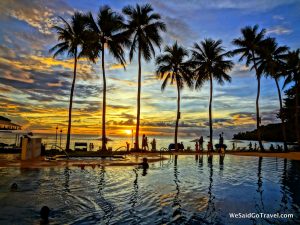 Whenever we arrive to a new place, we attempt to learn about the country. Therefore, our first stop in Palau was the Belau National Museum where the exhibit: “A Cherechar A Lokelii: Palau Through the Years” gave us a detailed introductory education. Strolling through the halls we learned about the past presence and influences of the Spanish, Germans, Japanese and the United States from a historical context.
Whenever we arrive to a new place, we attempt to learn about the country. Therefore, our first stop in Palau was the Belau National Museum where the exhibit: “A Cherechar A Lokelii: Palau Through the Years” gave us a detailed introductory education. Strolling through the halls we learned about the past presence and influences of the Spanish, Germans, Japanese and the United States from a historical context.
The Spanish first visited Palau in 1522 and later returned to govern the country as a colony from 1885-1899. They brought missionaries, who are still among the population of fewer than 25,000 people. Germany later purchased Palau from the Spanish due to their economic interest in coconut and phosphate mining. After World War I, Japan governed Micronesia from 1914-1945; they chose Koror as the headquarters for the region and focused on bringing education to the island, starting a school for the people of Palau in 1915. After World War II, Palau was governed as a Trust Territory of the Pacific Islands through the United Nations by the United States.
The Peace Corps sent 350 volunteers in 1966 and by 1968 volunteers flourished to over 800. During our visit in 2013, only three Peace Corps volunteers were still present, dwindling to zero since Palau is currently considered “developed.” In 1994, Palau became the 185th member of the United Nations, as it was an Independent State in Free Association with the United States. As the 19th anniversary approaches on October 1st, we enjoyed the opportunity to visit the “edge of paradise,” and learn about Palau. The Belau National Museum was opened in 1955 and has a replica of a Bai (a traditional men’s meetinghouse) located just outside the museum.
During our ten-day stay in Palau, the highlights included being in or under water amidst the gorgeous Rock Islands, inscribed as a UNESCO World heritage site in June 2012. Other worthwhile activities, however, are situated in and around Koror. At the Etpison Museum we met Elvis, the famous cockatoo who greets visitors near the museum entrance. The museum’s sizeable Dugong storyboard is one of many artifacts from where we learned more about Palau’s unique culture. In fact, the two-storied museum is filled with items of local importance. We learned about Udoud (Palauan money beads), Toluk (trays made from turtle shells), and Ngasech, the first birth ceremony that celebrates motherhood and often marriage.
The centrally situated Palau Aquarium is primarily an outdoors experience offering information about mangroves, sea grass and coral reef habitats. A touch tank permits visitors to learn about sea stars and sea cucumbers. The overall exhibit educates visitors about camouflage, living fossils and the importance of sea conservation. Sadly it is snorkelers and divers who are the largest potential danger for our underwater friends. Educating people to be careful on the reef by not touching or taking anything from the sea will help. Proper disposal of trash and not throwing anything into the ocean is also crucial.
Dolphin’s Pacific has been open for thirteen years and houses four adult bottlenose dolphins from Japan as well as Momiroi, the baby dolphin who was born in captivity in Palau. Dolphin’s Pacific is “the world’s largest marine mammal interaction, education and research facility.” The 200-million gallon saltwater lagoon offers several types of dolphin encounters from a handshake, to a day playing dolphin trainer. Visitors can even get married while dolphins leap in the background. Leaves that fall into the water can make dolphins ill if they consume them so the trainers have taught the dolphins to exchange leaves for either fish or ice treats. Our guide explained that trainers have “planted” over 1,000 clams to filter and maintain the waters clean for the dolphins and marine turtles. Stingrays also inhabit the lagoon. The quick boat ride from the mainland to Dolphin’s Pacific places visitors in an enjoyable locale where they can shake hands and interact in close proximity to friendly dolphins.
Yet another exclusive experience in Palau is to zipline. At Palau Adventure Park Zip Line Tour we experienced ziplining for the first time in our lives. This encounter was designed with families and first timers in mind. After a safety briefing, we were helped into our gear before descending the first of four lines. At this facility, the helpful staff breaks for clients so all that is required is watching the scenery sail by while gliding down the lines. By the third zipline, the staff requests that you go down backwards while the fourth line is the longest at over 220 meters.
Having completed the four ziplines, we arrived to a river where we boarded a jungle boat ride through a lovely canopy of mangroves. Then we briefly visited the site of a historic World War II canon from the Japanese army. On this desolate island, we sampled fresh coconut while standing amongst betel nut trees. After returning to the Palau Adventure Park Zip Line Tour office platform, we were treated to fresh coconut sashimi while we mailed postcards via the available slow post office; clientele can send postcards to themselves or family members that will arrive to the postmarked destination in one year and a day! The outgoing mail will remind visitors of the entertaining day they spent while ziplining, yet adding to many great memories to be had while traveling in Palau at the edge of the rainbow.


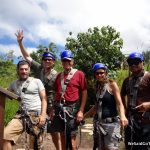

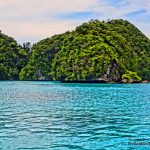
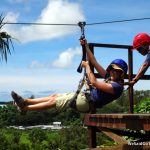
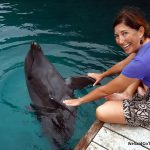
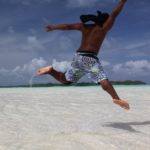

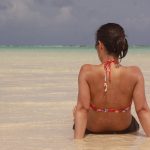
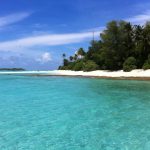
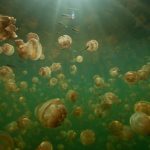

Palau is on my list….how did you get there…your route? Did you think 10 days was a good amount of time? Thanks for helping me plan!
Corinne – Palau has been one of my favorite trips to date – and I know Lisa and George (who wrote this article had a great time). I flew from Guam on United – sometimes they stop in Yap on the way. On the way back I flew through Osaka. There are a number of flights from both Guam and Japan to Palau. I was there about 9 days and it was the perfect amount of time – although even more time would be fine especially if you want to build in more R&R into the trip – I was participating in activities throughout the country during most of my visit.
Here is another article I wrote after my trip there which might help with your planning: http://www.davestravelcorner.com/journals/destination-asia/exploring-wonders-palau/ and if you search Palau on our site – a bunch of related info will come up.
~ Dave
Interesting article, especially because admittedly I knew nothing about Palau and certainly not about their short lived German past. Being a fan of all sorts of colonial traces, it would be interesting to know if you noticed any of the early European influences, in architecture, food or even culture…
Yes, there was Spanish influence and later, American influence during and after WWII. I believe the national capitol building was actually in part funded by the EU. The two best museums presenting these earlier influences are the Belau National Museum and Etpison Museum. I vaguely remember hearing that some of the older people on the islands may still speak Spanish – English is very widely spoken. Food – I remember a lot of seafood but don’t remember much in the way of outside culinary influences.
Thanks a lot for the detailed answer! That sounds overall like an interesting mix of different influences and it sounds even more so that Palau should make it onto the to-do list…